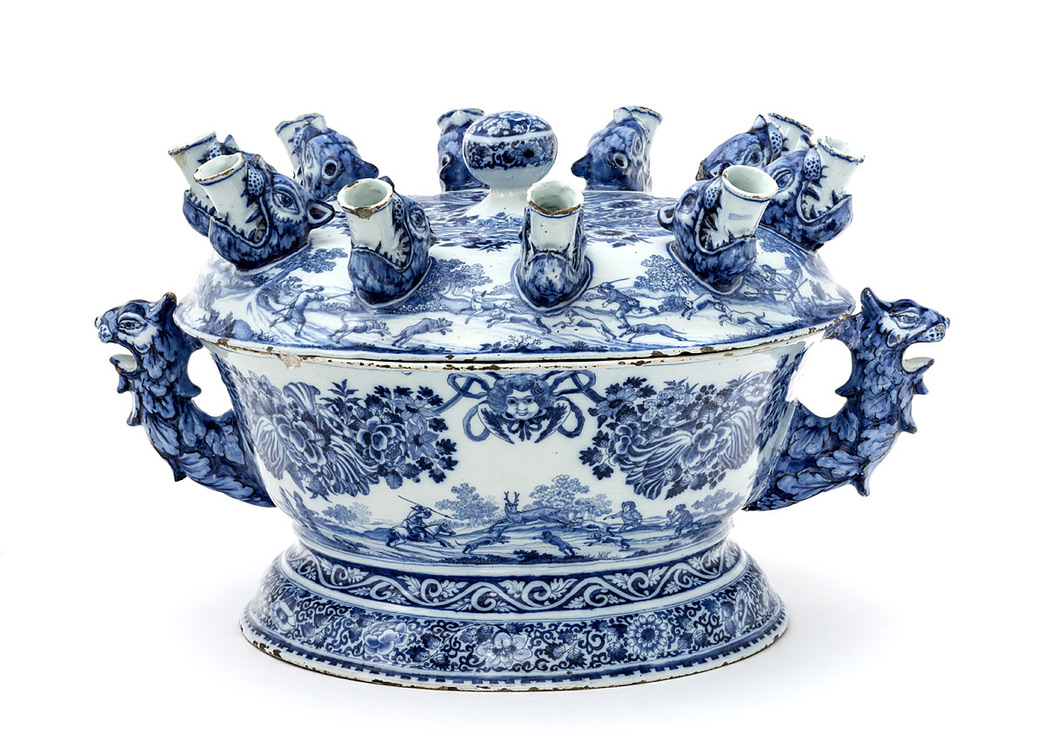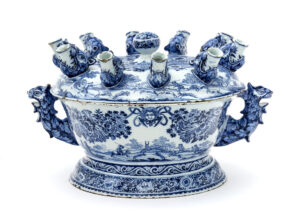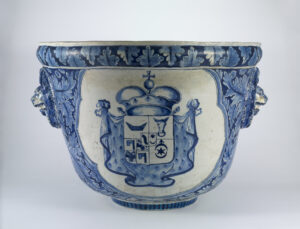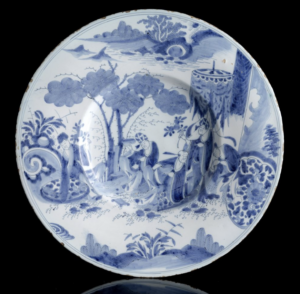
Beyond borders
Dutch seaborne trade and the spread of Delft faience in the Baltic region

(Fig. 1) Tulipière, Delft, circa 1690, marked AK for Adrianus Kocx, owner of ‘De Grieksche A’ (The Greek A) from 1686 until 1701, Collection of Museum für Kunst und Gewerbe in Hamburg, Inv. nr. Inv. nr 1891-282
The mother of all trade
The Dutch are well known for their commercial spirit, which has brought Dutch merchants all over the world, leaving physical, cultural, and even linguistic traces.(1) While the Dutch trade with Asia is most commonly known, the merchants also explored and traded with the Baltic region. In fact, the Baltic trade provided sufficient financial resources for the Dutch to explore areas of Asia. The Dutch statesman Johan de Witt (1625–1672) described the Baltic seaborne trade as ‘the mother of all trade’.(2) In this article we explain the importance of this trade for the spread of Delft faience in the Baltic area.
The Baltic seaborne trade was based on the exchange of raw materials, foodstuffs and minerals sourced from the East. The West provided rich commodities and domestically crafted industrial goods. This sophisticated trading system was based upon the pivotal role that staple markets played in the purchase and distribution of the commodities that were transported along the vast waterway stretching from the Finnish Gulf to the Danish Kattegat.(3)
Since 1429, every foreign ship passing through the Sound, a narrow water passage between Helsingør (DK) and Helsingborg (now SE) that gave access to the Baltic sea, was required to pay a toll. This toll system, established by King Erik I of Denmark, was an important source of income for the Danes. Denmark controlled both sides of the Sound at that time and the Sound was the main passage through the Baltic sea, which gave them maximum control. Ships could not pass through without paying, or they would be fired upon from Krönborg Castle, built especially for this purpose, located on a headland near Helsingør. The costs for the bullets fired were then charged to the Skipper, called ‘fyrepenge’.
According to Danish historian Ole Degn, over half of the passages through the Sound featured Dutch vessels. Additionally, sixty to seventy percent of freight could be traced back to Dutch origins.(4) Given its significance, it comes as no surprise that the Danish Sound Toll policy remained a persistent source of tension in the interactions between the Dutch Republic and Denmark. The Danish authorities aimed to bolster their trading position, achieving this goal by raising toll charges. This move allowed the Danish monarch not only to collect a portion of the Dutch profits but also to erode the dominant Dutch position in European freight traffic to their own advantage. In a period marked by upheaval, King Frederik Hendrik of the Dutch Republic diligently worked to maintain peace among disgruntled merchants due to his concerns about a potential war with Denmark. However, the situation eventually shifted in the Dutch Republic’s favor. In 1645, faced with the looming threat of war, the Dutch successfully pressured Denmark to reduce toll rates. This was not the final conflict in the region.
The Great Northern War (1700-1721) strengthened the influence of Russia in the region. After the founding of Saint Petersburg in 1703, a port was established to provide access to the Baltic Sea. This marked a major advance in trade and Saint Petersburg was called the ‘window on Europe’.(5) From 1721 Estonia was part of the Russian Empire, which expanded Baltic Sea trade even further. Russia was considered the new superpower in the Baltic Sea.
In the seventeenth century and beyond, the Dutch Republic boasted the highest living standards among its neighboring countries. The allure of Dutch craftsmanship, technology, industry, and the goods it produced sparked significant foreign interest. This interest reached even into the royal circles of Tsar Peter the Great (1672-1725). In 1697, he visited both Zaandam and Amsterdam, where he gained insights into various shipbuilding techniques, and also discovered the beauty of Delft faience and Dutch tiles. His endorsement elevated tiles, showcasing them as both highly decorative and utilitarian. Even though the majority of these tiles were not crafted in Delft but rather in Rotterdam, Amsterdam, Utrecht, or at a production facility in Friesland, they have come to be recognized as ‘Delft’ tiles.(6) This nomenclature underscores the widespread renown of Delft pottery well beyond national boundaries. The fact that tiles have been regularly used as ballast and merchandise on board of Dutch trading vessels on their way to the Baltics, as described by Eveline Reitz in her article ‘The use of tiles as ballast on trading vessels’, shows that we aren’t talking about occasional transports.(7) For those reasons, it remains interesting to include the export of tiles in this context.
The presence of Delft faience in the Baltic region
Christoffel Brants (1664-1732), a prominent Amsterdam merchant, was a special envoy of Tsar Peter. In this role, he made significant contributions to the dissemination of Dutch tiles and, potentially, Delft faience in Russia. Brants resided in Moscow for an extended period and subsequently returned to Amsterdam in the year 1705.(8) While serving Tsar Peter he also catered to the artistic and architectural needs of other royals and nobles, including A. D. Menshikov and F. M. Apraksin. He scoured the Dutch Republic for the finest art, decoration, and construction materials. As a result, numerous Russian palaces were adorned with Dutch tiles, with one of the most renowned examples being the palace of A.D. Menshikov in Saint Petersburg. Remarkably, this palace boasts an impressive collection of ten thousand Dutch tiles, as well as Delft faience.(9)
The promotion of Delft faience in the Baltic region was primarily through skippers and merchants.(10) They exported Delftware on regular trade routes to the Baltic sea cities of Danzig, Elbinger and Köningsberg. The main commodities transported from the towns along the Baltic coast were primarily grain, timber, and furs. Yet, Dutch vessels did not traverse to the Baltic without cargo. According to a museum director in Danzig, H.F. Secker, who wrote in 1917, the oversea transport of Delft faience was organized on the same basis; as ballast and merchandise.(11) His statement is substantiated by historical records, for example by the Frigate ‘Vriendschap,’ under Dutch command of Sijbrand Giels, which embarked on a voyage from Rotterdam through Amsterdam to St. Petersburg in July 1758. A notarial deed in the Amsterdam city archive describes the cargo on the outward journey as ‘ballast’ which is further specified as a cargo including ‘porcelain,'(12) valued at 65 Reichsdaalders in the Sound Toll register dated August 15, 1758.(13) The Sound Toll register shows that the previous example was one of the many Dutch ships that carried ‘porcelain’ as part of the ballast.
Besides Russia, Delft pottery has left a lasting impression across the Baltic region with notable collections in Sweden, Germany, Estonia, Latvia, Lithuania, and Poland. Delft faience of different quality can be found in many museum and private collections. The collection at Skokloster Slot in Stockholm for example, includes a rare seventeenth century Delft tazza with chinoiserie decor(14) and a pair of candlesticks from the same period.(15) The Museum für Kunst und Gewerbe in Hamburg contains a stunning ‘tulipière’, marked AK for Adrianus Kocx, owner of ‘De Grieksche A’ (The Greek A) from 1686 until 1701 (Fig. 1).(16) These collections could easily be a subject for future essays, as many of them have not been researched yet.
In many instances, establishing the arrival of these ceramics in the Baltic area through maritime trade routes and their timeframe poses challenges due to limited available sources.
It is worth noting that a significant portion of Delftware in museum collections was acquired during the nineteenth century, reflecting a resurgence of interest in Delft pottery. Despite this, the presence of Delftware generally signifies a connection with the Netherlands in the seventeenth and eighteenth centuries.
Gdansk
One city that stands out prominently in this context is Gdansk (Danzig), Poland. Gdansk provides a unique focus within this study due to the availability of compelling sources, including archaeological discoveries and estate inventories. Delftware is a frequent find in archaeological excavations.(17) Several factors contribute to Gdansk’s strong ties with the Netherlands. Approximately half of the revenue for Dutch Baltic Sea traders in the seventeenth century was generated with trade from Gdansk.(18) The harbor functioned as a transfer station for further distribution inland.(19) Additionally, the city became home to a significant Dutch expatriate community, including individuals leaving for religious reasons and those seeking economic opportunities. The Dutch citizens in Gdansk introduced typical interior aesthetics, such as a specific style of cupboard prevalent in the Dutch Republic. Grand Delft garniture sets often adorned these cupboards. Johann Carl Schultz’s nineteenth-century etchings provide valuable insights into interior scenes of this era, showcasing the utilization of Dutch tiles and Delft faience (Fig. 2). These visual records gain added importance due to the regrettable destruction of numerous remnants of interiors with Dutch tiles and Delft faience during the conclusion of the Second World War in Gdansk.

Seven interiors with Dutch tiles, and in some cases Delft faience, in Gdansk have survived, serving as a valuable historical in situ source.(20) About thirty interiors in Poland are still present.(21) One of the surviving examples is the Faience Cabinet in Wilańow Palace in Warsaw, dating from 1690. The Palace contains 122 tile murals by Amsterdam based tile producer Jan van Oort (1645-1699), supplemented with tiles from the tile factory of his brother Gerardus from Utrecht. The collection of the Palace also contains pieces of Delftware. Most interesting is this large jardiniere with the coat of arms of Elżbieta Sieniawska (1660-1729) Fig.3.(22) Elżbieta was an influential Polish noble women, also known as the uncrowned queen of Poland. According to the curators references, the jardinière was most likely ordered by Elżbieta herself.

Archaeological excavations in Gdańsk have uncovered a substantial amount of Delftware attributed to De Drie Posteleyne Astonne (The Three Porcelain Ash Barrels) from the period of Gerrit Kam’s ownership (1679–1700). A particularly significant type of Asian-inspired decoration has been found in large quantities, featuring Chinese figures set in a landscape with a distinctive tree bearing five crowns (Fig. 4). Several objects with this decoration, marked as or attributed to Kam, are preserved in the collection of the National Museum in Gdańsk.(23) The design became so popular that local pottery makers began producing imitations. However, the differences are evident, as the locally made versions are of noticeably lower quality than the original Delftware.(24)

Summary
Delft faience in the Baltic region is part of the rich Dutch legacy of the lively Baltic seaborne trade. While the origin is not always known, and often lacks a trace back to the seventeenth century, the existence of Delft faience in the region signifies the strong connection with the Netherlands. Future research may uncover additional details and collections that contribute to expanding our knowledge and understanding of Delft faience and provide a broader perspective on the connection between the Netherlands and the Baltic region.
Notes
- Cristopher Jody, ‘Draining and Building: The Dutch in the Baltic Sea Region’, 2019, thelowcountries.com, (link to article)
- Aronson Antiquairs, ‘The Young Nightingale’, April 2023, aronson.com, (link to article)
- Hanno Brand,’BALTIC CONNECTIONS, Changing Patterns in Seaborne Trade, c. 1450-1800′, Boston/Leiden, 2007, (Link to article)
- Suzanne Hendriks, ‘Geld uit graan’, 2023, Historisch Nieuwsblad, (link to article)
- Piet de Buck e.o., ‘Notariele akten over de Archangelvaart 1594-1724, Historische inleiding: de Hollandse Archangelvaart‘, Huygens Instituut, (link to article)
- Piotr Oczko, Jan Pluis, ‘Dutch tiles in Poland: A Short Survey’ in CODART eZine, no. 8, September 2016, codart.nl, (link to article)
- Eveline Reitz,’The use of tiles as ballast on trading vessels’ in: The Itineraries of Art Topographies of Artistic Mobility in Europe and Asia Edited by Karin Gludovatz, Juliane Noth, Joachim Rees, Wilhelm Fink, Paderborn, 2015
- L.P. Dorofeëva, ‘Hollandse tegels toegepast in het Petersburgse Paleis van A. D. Mensjikov’, in Tegel 24, Zeist 1996, p. 22
- Dorofeëva, p. 20
- Rudolph, Wolfgang, ‘Seefahrer-Souvenirs. Steingut, Fayence und Porzellan aus 3 Jahrhunderten’, Leipzig, 1982, p. 35
- Idem
- Although now known as Delft faience or Delftware, in the seventeenth and eighteenth century, the term ‘porcelain’ written in various forms was commonly used to describe Delftware. This convention persisted even after J.F. Böttger’s invention popularized genuine kaolin porcelain production in other European countries. Even in the late 18th century, Gerrit Paape (1752-1803) continued to employ this term in his treatise ‘De Pottenbakker’ form 1794. When researching Delft faience in archives, one may encounter the term ‘porcelain’ to describe such items. However, it’s essential to exercise caution in interpretation, as this term may refer to Asian porcelain.
- Amsterdam City Archive, 1758, Sijbrand Giels, notary archive, archive number 5075, inventory number 10774, deed number 191709, (link) and Sound Toll register, Siebrand Giels, Register: Chr. A. Bluhme 1758, ID 437026, passage 257, August 15, 1758 (link to page)
- Skoklosters Slott Collection, Inv. nr. 665_SKO (link to page)
- Skoklosters Slott Collection, Inv. nr. 674_SKO (link to page)
- Museum für Kunst und Gewerbe Collection, Inv. nr 1891-282 (link to page)
- Joanna Dąbal, ‘Wisłoujście Fortress, Gdańsk Archaeological and architectural investigations 2013–2014‘, Institute of Archaeology and Ethnology, University of Gdańsk, Historical Museum of Gdańsk, Gdansk, 2015, p. 243
-
Maria Bogucka, Amsterdam and the Baltic in the First Half of the Seventeenth Century, in: The Economic History Review, Vol. 26, No. 3 (1973), pp. 433-447
-
Katarzyna Korczak, ‘130-lecie gdańskiego muzealnictwa’, in Trojmiasto, 2003 (link to article)
-
Oczko, Pluis, 2016, chapter 11
-
Jaap Jongstra, ‘Delfts Blauw: van imitatie tot wereldmerk’ in Karin Gaillaard, ‘Made in Holland’, Waanders Uitgevers Zwolle/Keramiekmuseum Princessehof Leeuwarden, 2018, p. 30
-
Silva Rerum,Jacek Kuśmierski,‘Wilanów citrus collection in the eighteenth century’, published at (link to article), 2021
-
Collection of the National Museum of Gdansk, Inventory numbers: MNG/SD/327/CS, MNG/SD/328/CS, MNG/SD/350/CS, MNG/SD/358/CS, MNG/SD/360/CS, MNG/SD/346/CS, MNG/SD/316/CS. With thanks to Magdalena Podgórzak, curator Ceramics and glass.
-
Jaap Jongstra, p. 35
Literature
Bogucka, Maria, ‘Amsterdam and the Baltic in the First Half of the Seventeenth Century’, in: ‘The Economic History Review‘, Vol. 26, No. 3 (1973)
Brand, Hanno. ‘BALTIC CONNECTIONS: Changing Patterns in Seaborne Trade, c. 1450-1800.’ Boston/Leiden, 2007. (link to article)
Dąbal, Joanna, ‘Wisłoujście Fortress, Gdańsk Archaeological and architectural investigations 2013–2014‘, Institute of Archaeology and Ethnology, University of Gdańsk, Historical Museum of Gdańsk, Gdansk, 2015
Dorofeëva, L.P. ‘Hollandse tegels toegepast in het Petersburgse Paleis van A. D. Mensjikov’, in ‘Tegel’ 24, Zeist, 1996
Hendriks, Suzanne, ‘Geld uit graan’, 2023, Historisch Nieuwsblad, (link to article)
Jody, Cristopher, ‘Draining and Building: The Dutch in the Baltic Sea Region’, 2019, on: (link to article)
Jongstra, Jaap, ‘Delfts Blauw: van imitatie tot wereldmerk’ in Karin Gaillaard, ‘Made in Holland’, Waanders Uitgevers Zwolle/Keramiekmuseum Princessehof Leeuwarden, 2018
Korczak, Katarzyna, ‘130-lecie gdańskiego muzealnictwa’, in Trojmiasto, 2003 (link to article)
Oczko, Piotr, Jan Pluis, ‘Dutch tiles in Poland’ in CODART eZine, no. 8 Autumn 2016
Reitz, Eveline, ‘The use of tiles as ballast on trading vessels’ in: The Itineraries of Art Topographies of Artistic Mobility in Europe and Asia Edited by Karin Gludovatz, Juliane Noth, Joachim Rees, Wilhelm Fink, Paderborn, 2015
Rerum, Silva, Jacek Kuśmierski,‘Wilanów citrus collection in the eighteenth century’, 2021, published at (link to article)
Rudolph, Wolfgang, ‘Seefahrer-Souvenirs. Steingut, Fayence und Porzellan aus 3 Jahrhunderten’, Leipzig, 1982



